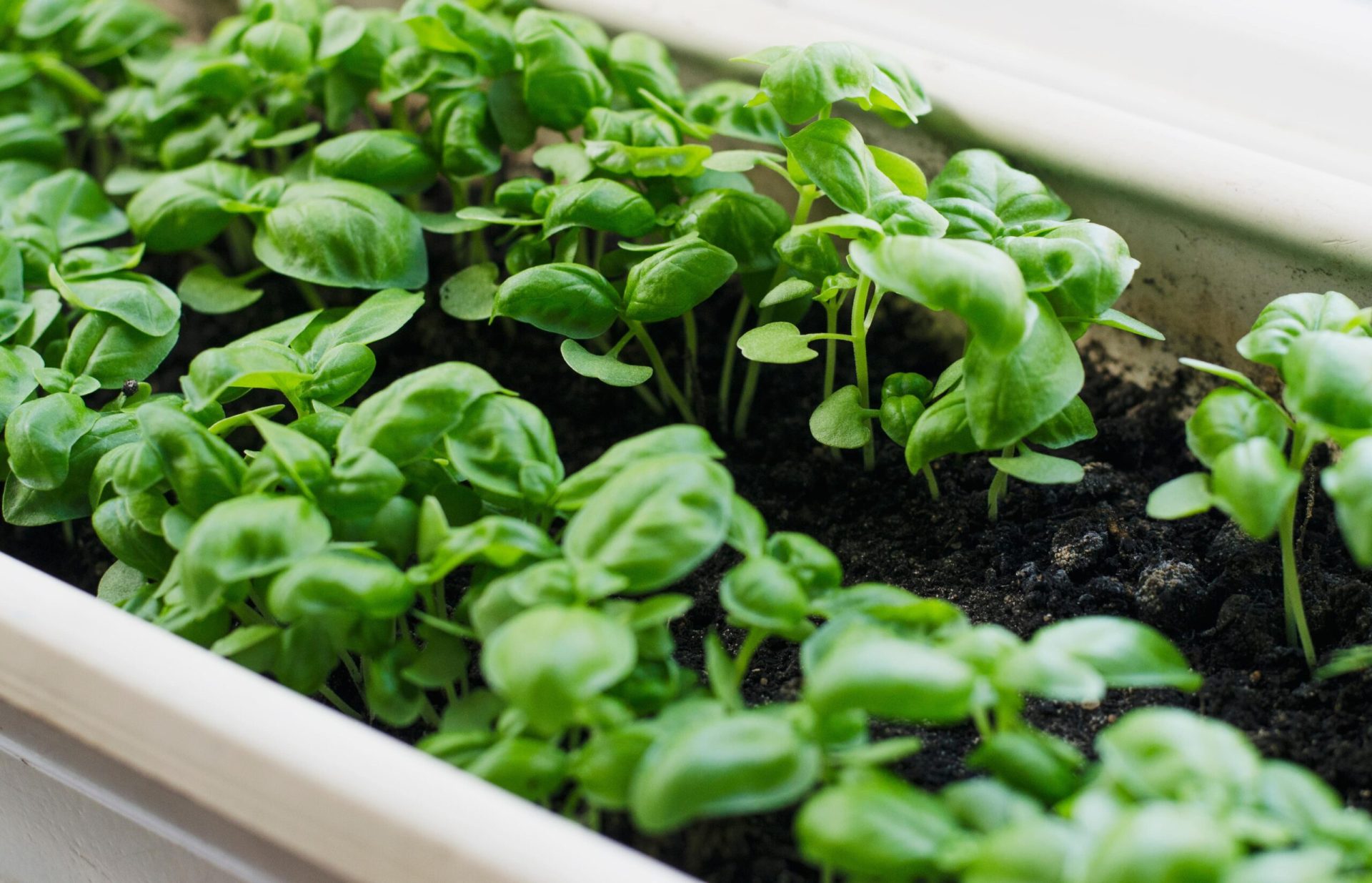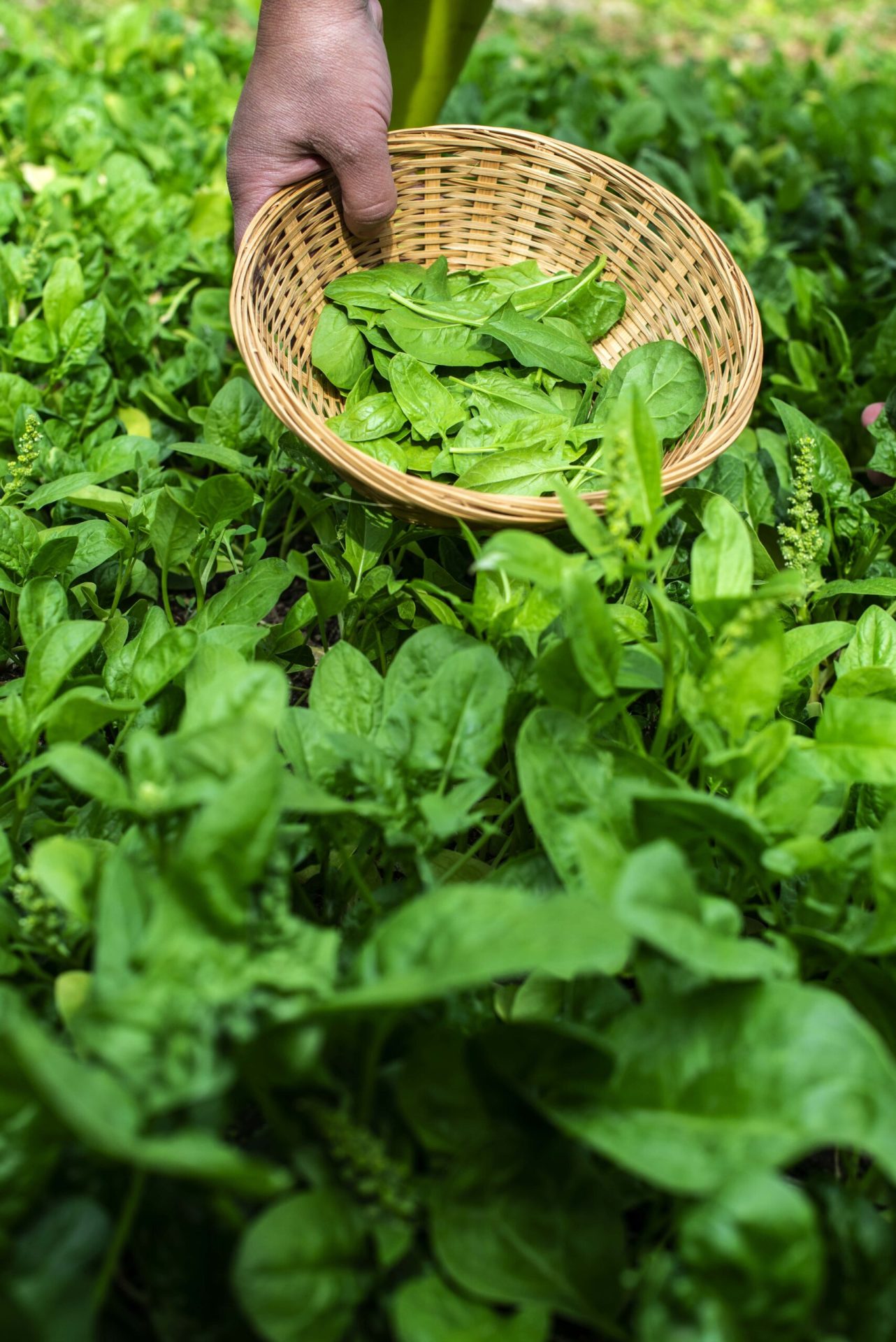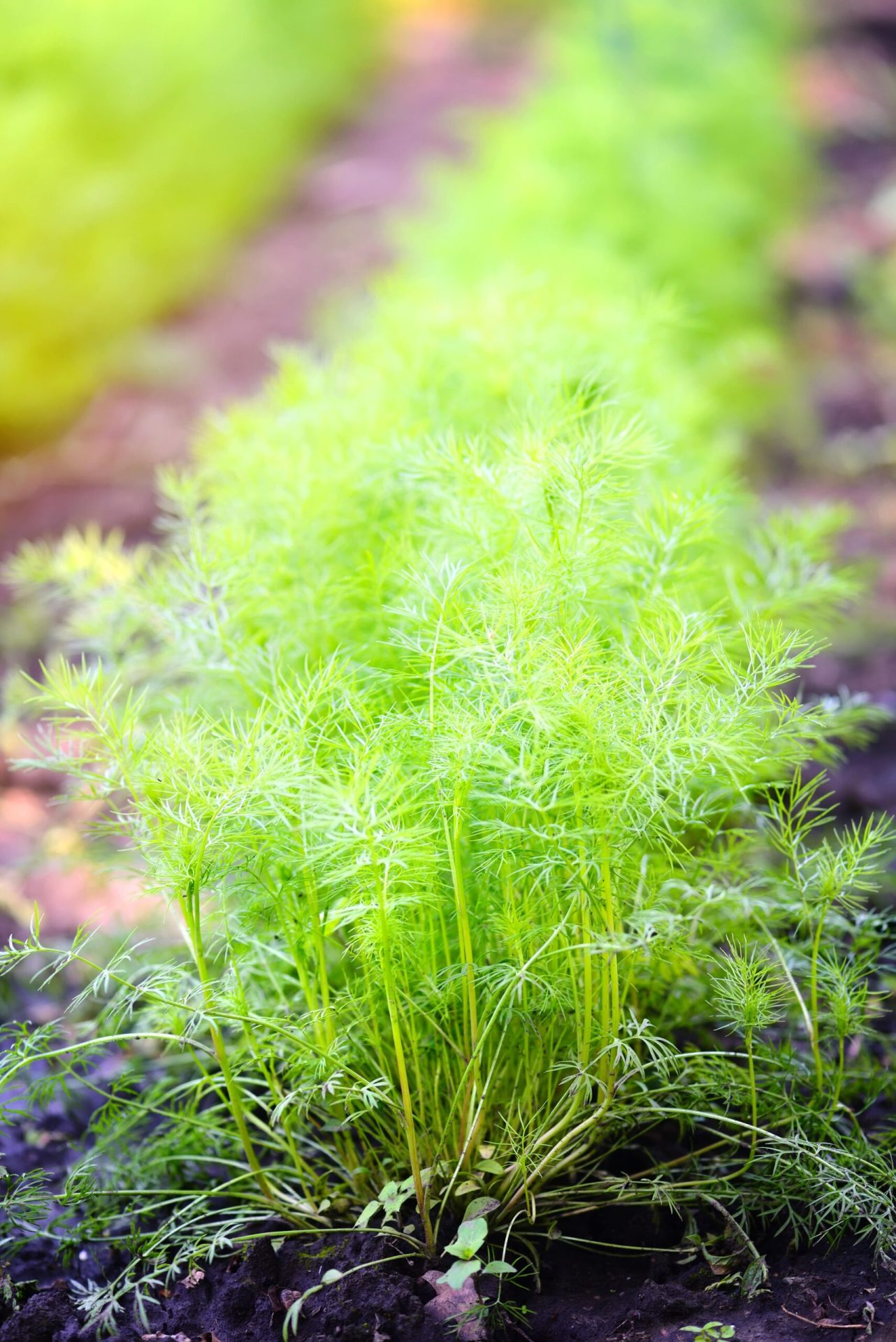Basil is one of the best homegrown herbs you can grow. It’s full of vibrant flavor, and a staple in Italian and Thai cuisine. This fragrant herb is a must-grow in your garden, and fortunately, growing basil successfully is fairly simple.
Need some ideas and tips for growing basil? This quick growing guide provides an overview of basil growth stages, as well as growing requirements, and step-by-step processes. Bottom line, this is an herb you’ll love to grow. Keep reading to learn how to grow this amazing herb.
Growing Basil 101: Step-by-Step Guide
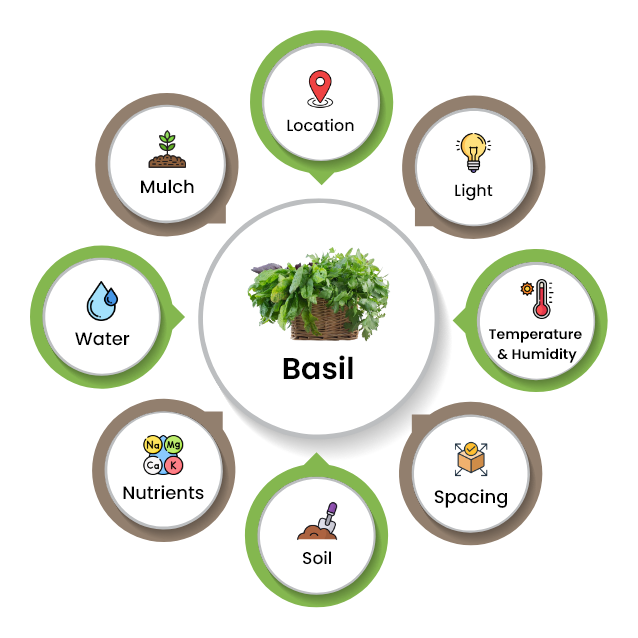
1. Location
Basil requires well-draining soil and a sunny location. Although you can directly sow in-ground, basil is commonly grown in containers, pots, and raised beds, due to the improved drainage.
2. Sunlight
Basil requires full sun, or 6-8 hours of sunlight per day for healthy growth. This is a heat-loving plant; a bright location is necessary.
3. Temperature & Humidity
Basil grows best and remains productive at temperatures between 70-85°F (21-29°C). The ideal humidity range for basil cultivation should be 70-85% (which is important if grown indoors).
4. Spacing
Plant basil in rows spaced 24-36 inches apart, with 8-12 inches between plants. In a raised bed, you can plant basil in closer rows about 12 inches apart.
5. Soil
Basil requires a soil pH between 6 and 7. You can balance your soil by incorporating organic nutrients like blood meal, compost, and cottonseed meal.
6. Fertilizer
You can use an organic, liquid fertilizer with a 5-10-5 NPK value. Mix half of the recommended dose of fertilizer into the water for plants once every 4-6 weeks.
7. Water
Keep the soil around your basil plants moist. This herb typically require 1 inch of water every week. Water at least once weekly to keep roots growing deep and the soil moist.
8. Mulch
Add 2-4 inches of organic mulch like hay, straw, chopped leaves. Wait until the plant is at least 6 inches tall to mulch.
How to Grow Basil Indoors?
If you are growing basil from seed, the germination process takes 7-10 days.
Follow the below steps to grow basil indoors:
1. Source quality basil seeds.
2. Sow seeds about 6-8 weeks before the last frost in spring.
3. Sow seeds ¼ inches deep in nutrient-rich potting soil.
4. Keep the soil moist at 70°F.
5. Seedlings emerge in 7-14 days after being planted.
6. Transplant seedlings to a raised bed outside or keep them in a container for better control over their growth.
How to Grow Basil in Pots?
Growing basil from seed can be a little new if you have not done this before, but basil is easy to grow. Here are some tips:
- Before the last frost, plant 5-6 basil seeds per pot or in a seed starter kit, 4-6 weeks in advance.
- Use seed-starting mix, coconut coir, or potting soil, and mix it to keep it slightly moist but not soggy.
- After planting, seeds will germinate in a week.
- Once they have a set of true leaves, thin them down to one or two seedlings for every pot.
How to Grow Basil in Containers?
Growing basil in containers is a convenient and space-saving way to enjoy fresh herbs. People who have limited garden spaces, growing basil in containers is an ideal option to keep herbs close at hand.
To grow basil in containers, you need to follow below steps:
1. Select a container with good drainage holes as it will prevent water logging. The pot should be 6-8 inches deep and 12-18 inches in diameter. This will provide space for the basil roots to grow and develop.
2. Use a well-draining, high-quality potting mix that contains organic matter. Ensure the soil is slightly acidic to neutral (pH 6.0-7.0).
3. Sow seeds ¼ inch deep in the soil. Cover it lightly with soil and water gently. In the case of seedlings, transplant them into the container and bury them at the same height as they were initially in the nursery container.
4. Place the container in a location that receives 6-8 hours of sunlight daily.
5. Water it when the top inch of the soil is dry. Ensure proper drainage to prevent root rot.
When to Plant Basil?
You can plant basil in late spring, summer, and autumn as it requires warmth. Many choose to plant basil successively, so they have fresh leaves to use throughout the growing season.
How to Plant Basil?
Plant basil at the right time for proper growth. Basil thrives in warm temperature, so plant it outside after the last spring frost.
If you are growing plants from seed indoors, start them at least 6-8 weeks before planting them outside.
You can plant basil outdoors once the temperature gets warm in early summer at a minimum of 15°C (59°F). The plant requires a sheltered, warm, sunny sowing site with free-draining soil. You should protect seedlings from snails and snugs. You can sow basil in containers of multi-purpose compost.
Basil Growing Stages
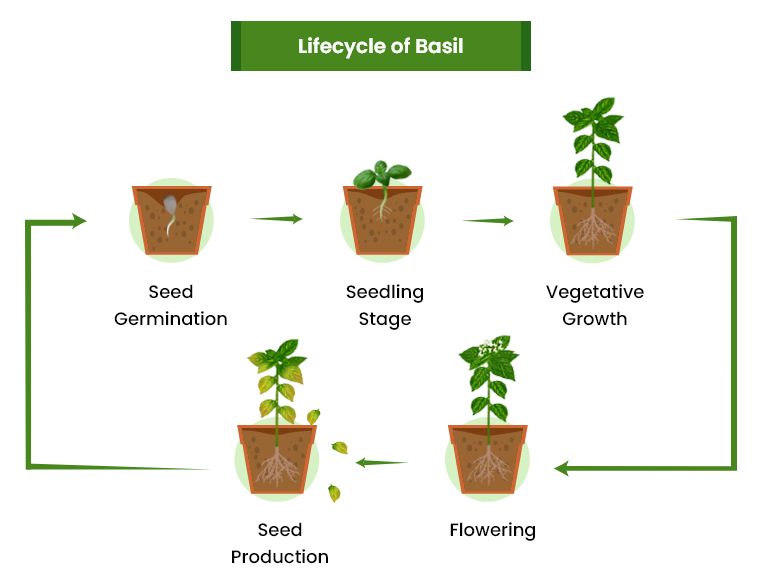
1. Seed Germination
The seed germination takes place in 5 to 10 days. Basil seeds require warm soil for the germination process. The best time to start seeds indoors is about 6-8 weeks before the last frost. Use a well-draining seed starting mix and moisten the soil.
TIP: Cover the seeds lightly with soil, as they require light to germinate. For this, maintain a temperature of about 70-75°F (21-24°C) for optimal germination.
2. Seedling
The seedling stage lasts about 2 to 4 weeks. Once the seedlings emerge, provide adequate sunlight. If you are growing basil plants indoors, use a fluorescent light or a sunny windowsill.
TIP: Keep the soil consistently moist but not soggy. Seedlings require good air circulation to the soil to avoid damping off, as it might cause fungal diseases in young seedlings.
3. Vegetative Growth
The vegetative stage occurs over the next 4-6 weeks. Basil plants thrive in full sun but can tolerate partial shade. Water plants consistently and ensure the soil is well-draining. Pinch off the tips of the stems for bushier growth.
TIP: Harden off seedlings by exposing them to outdoor conditions before you transplant them.
4. Flowering Stage
The flowering stage usually occurs around 6-8 weeks after planting. When the basil plant matures, it produces flower stalks. Flowers can change the taste and decrease the amount of leaves the basil plant produces.
TIP: Pinch off the flower buds to encourage the plant to grow leaves. If you are growing basil for seeds, allow a few plants to flower and go to seed.
5. Harvesting
Once the basil plant has reached an appropriate size, it’s time to harvest it. Harvest basil leaves regularly, particularly in the morning when the oils in the leaves are most concentrated. To harvest basil, use clean and sharp scissors to snip its leaves without causing damage to the plant.
TIP: To get more leaves and keep the plant in shape, regularly pick basil plants and prevent them from growing too tall.
When to Harvest Basil?
Whether you start your basil from seeds or a young plant, the best time to harvest basil will depend on the size of the plant. The right time is when the basil plant has unfurled at least four sets of leaves.
The basil plant should grow between 6 and 8 inches tall before you harvest its leaves. If you know when you seeded the plant, you can harvest your basil 60 to 70 days later.
How to Harvest Basil?
The best time to harvest basil leaves is in the morning after the dew has evaporated from the plants. When the cold weather arrives after the summer, harvest your basil before frost kills the plant.
The right way to harvest basil is to pinch leaves off where the leaf meets the stem. Harvest leaves from the top of the plant, where more foliage quickly fills in. For flavorful leaves, harvest basil before the flowers appear.
How to Prune Basil?
The best time to start pruning basil is when small flowers grow on your plants or reach more than 6 inches in height. Remove the flowers and leave the stems alone.
Pinch off the flower buds as soon as they appear. Prune frequently to keep the blooms at bay and prevent the stems from becoming woody. When the stems become woody, the basil turns bitter.
How to Store Fresh Basil?
Two methods to store fresh basil are to treat it like flowers in a vase with water or wrap it in paper towels and store it in the fridge. In both these methods, you should wait to wash the basil before using it, as excess moisture will cause it to rot quickly. When stored in either of these ways, you can keep basil fresh for 1-2 weeks.
First method: When you store basil, trim and discard the ends of the basil stems. Store it in a vase with a few inches of cool water, and keep it out of the sunlight at normal room temperature. Regularly change the water every few days.
Second method: Wrap the basil in a paper towel to absorb excess moisture. Store the basil in an airtight food storage container or a zipper plastic bag and keep it in the crisper drawer in the fridge.
Can You Freeze Basil?
You can freeze basil, but it won’t be the same as when you thawed it. To freeze basil for sauce or green paste, blend it with a little olive oil in a blender or food processor. Pour this prepared mixture into an ice cube tray and pop it in the freezer.
To use frozen basil, you can either add a cube to your soup or melt it in a hot pan. This will help to infuse your dish with the delicious flavor of basil.
Best Basil Varieties
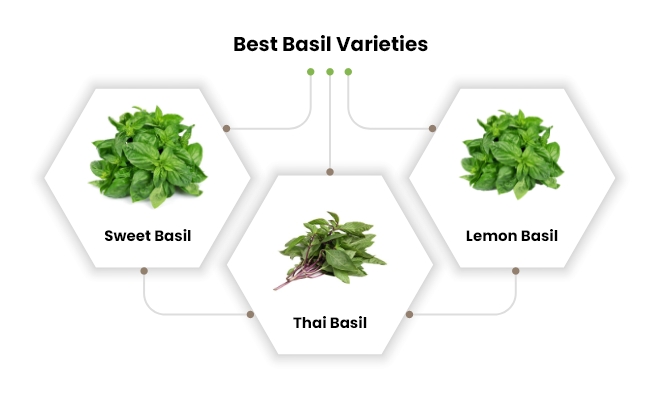
1. Sweet Basil
This basil variety is the widest-grown type of basil. It has rounded, cup-shaped leaves with a classic spicy clove flavor. Its aromatic foliage makes it extensively useful in cooking.
Ranging from green to purple, this basil variety can reach a height of 12-18 inches. People often use basil in pizza, Caprese salad, and pasta & pesto dishes.
2. Thai Basil
This sweet-scented basil variety is slightly spicy and has a licorice-like flavor. It has small, pointy leaves, purple flowers, and stems. Its leaves hold up well even in high-temperature cooking than other basil varieties. It can attain a height of 12-24 inches.
Both its leaves and flowers are edible. Curry sauces, spring rolls, rice, Thai stir fries or curries, noodle-based dishes, and spring rolls use it.
3. Lemon Basil
This basil variety is an essential part of Indonesian cuisine. This hybrid variety has a sweet-tart flavor, fresh lemon scent, and lighter green leaves with jagged edges. The plant will grow and develop to a height of 12-24 inches with stalks of 12 to 24 inches.
People eat this basil variety fresh in salads and wraps and also use it in stews, curries, marinades, soups, confections, and stir-fries. This heat-loving basil variety grows well in containers and gardens.
Common Pests & Diseases
Even though basil is one of the popular herbs to grow, this doesn’t mean there are no pests or disease problems. Some basil diseases make the leaves turn yellow or brown, develop spots, or even wilt and fall off.
Common pests that affect basil growth are aphids, whiteflies, spider mites, slugs and snails, cutworms, and Japanese beetles. Basil plants can get sick from diseases like mildew, wilt, leaf spot, and root rot.
Preventive Measures to Take Care of Basil:
- Choose basil varieties that are resistant to specific diseases.
- Remove and destroy infected plants to prevent the spread of diseases.
- Avoid overhead watering as it develops fungal diseases.
- Having good soil drainage is important to prevent soggy conditions, that results in root rot.
- Planting basil with other companion plants helps deter certain pests.
- Monitor basil plants regularly to detect early signs of pests or diseases. Early detection helps to take prompt action.
- Consider using natural predators to control the pest population.
- Consider crop rotation. Avoid planting basil in the exact location in consecutive growing seasons to reduce the chances of soil-borne diseases.
Basil Companion Planting
Companion plants help a specific crop grow or grow better besides a specific crop. It helps repel bugs and attracts helpful bugs in your garden. Additionally, it improves soil and covers the ground. Moreover, it gives shade and aids basil plant growth.
You can produce a flavorful and robust garden by planting basil with certain companion plants.


